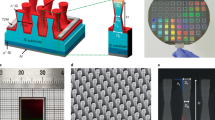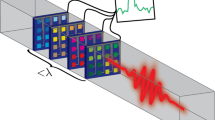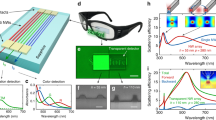Abstract
Sensing the direction of sounds gives animals clear evolutionary advantage. For large animals, with an ear-to-ear spacing that exceeds audible sound wavelengths, directional sensing is simply accomplished by recognizing the intensity and time differences of a wave impinging on its two ears1. Recent research suggests that in smaller, subwavelength animals, angle sensing can instead rely on a coherent coupling of soundwaves between the two ears2,3,4. Inspired by this natural design, here we show a subwarvelength photodetection pixel that can measure both the intensity and incident angle of light. It relies on an electrical isolation and optical coupling of two closely spaced Si nanowires that support optical Mie resonances5,6,7. When these resonators scatter light into the same free-space optical modes, a non-Hermitian coupling results that affords highly sensitive angle determination. By straightforward photocurrent measurements, we can independently quantify the stored optical energy in each nanowire and relate the difference in the stored energy between the wires to the incident angle of a light wave. We exploit this effect to fabricate a subwavelength angle-sensitive pixel with angular sensitivity, δθ = 0.32°.
This is a preview of subscription content, access via your institution
Access options
Access Nature and 54 other Nature Portfolio journals
Get Nature+, our best-value online-access subscription
$29.99 / 30 days
cancel any time
Subscribe to this journal
Receive 12 print issues and online access
$259.00 per year
only $21.58 per issue
Buy this article
- Purchase on SpringerLink
- Instant access to full article PDF
Prices may be subject to local taxes which are calculated during checkout

marima/Shutterstock.com




Similar content being viewed by others
Change history
15 November 2018
In the version of this Letter originally published, Zongfu Yu was mistakenly not noted as being a corresponding author; this has now been corrected in all versions of the Letter.
References
Grothe, B., Pecka, M. & McAlpine, D. Mechanisms of sound localization in mammals. Physiol. Rev. 90, 983–1012 (2010).
Chung, S.-H., Pettigrew, A. & Anson, M. Dynamics of the amphibian middle ear. Nature 272, 142–147 (1978).
Miles, R. N., Robert, D. & Hoy, R. R. Mechanically coupled ears for directional hearing in the parasitoid fly Ormiaochracea. J. Acoust. Soc. Am. 98, 3059–3070 (1995).
Römer, H. & Schmidt, A. K. D. Directional hearing in insects with internally coupled ears. Biol. Cybern. 110, 247–254 (2016).
Mie, G. Beiträge zur Optik trüber Medien, speziell kolloidaler Metallösungen. Ann. Phys. 330, 377–445 (1908).
Cao, L. et al. Engineering light absorption in semiconductor nanowire devices. Nat. Mater. 8, 643–647 (2009).
Kuznetsov, A. I., Miroshnichenko, A. E., Brongersma, M. L., Kivshar, Y. S. & Luk’yanchuk, B. Optically resonant dielectric nanostructures. Science 354, 2472 (2016).
Ng, R. et al. Light Field Photography with a Hand-Held Plenoptic Camera, Computer Science Tech Report 2005-02 (Stanford University, 2005).
Wang, A., Gill, P. & Molnar, A. Light field image sensors based on the Talbot effect. Appl. Opt. 48, 5897–5905 (2009).
Wang, A. & Molnar, A. A light-field image sensor in 180 nm CMOS. IEEE J. Solid-State Circuits 47, 257–271 (2012).
Wang, A., Gill, P. & Molnar, A. in Proceedings of the IEEE Custom Integrated Circuits Conference 371–374 (IEEE, New York, 2009).
Sivaramakrishnan, S., Wang, A., Gill, P. R. & Molnar, A. in Proceedings of the 2011 IEEE International Electronic Devices Meeting 191–194 (IEEE, New York, 2011).
Pollack, G. S. Sensory cues for sound localization in the cricket Teleogryllus oceanicus: interaural difference in response strength versus interaural latency difference. J. Comp. Physiol. A 189, 143–151 (2003).
Christensen-Dalsgaard, J. & Manley, G. A. Directionality of the lizard ear. J. Exp. Biol. 208, 1209–1217 (2005).
Christensen-Dalsgaard, J., Tang, Y. & Carr, C. E. Binaural processing by the gecko auditory periphery. J. Neurophysiol. 105, 1992–2004 (2011).
Vossen, C., Christensen-Dalsgaard, J. & van Hemmen, J. L. Analytical model of internally coupled ears. J. Acoust. Soc. Am. 128, 909–918 (2010).
Vedurmudi, A. P. et al. How internally coupled ears generate temporal and amplitude cues for sound localization. Phys. Rev. Lett. 116, 28101 (2016).
Suh, W., Wang, Z. & Fan, S. Temporal coupled-mode theory and the presence of non-orthogonal modes in lossless multimode cavities. IEEE J. Quantum Electron. 40, 1511–1518 (2004).
Verslegers, L., Yu, Z., Catrysse, P. B. & Fan, S. Temporal coupled-mode theory for resonant apertures. J. Opt. Soc. Am. B 27, 1947–1956 (2010).
Verslegers, L., Yu, Z., Ruan, Z., Catrysse, P. B. & Fan, S. From electromagnetically induced transparency to superscattering with a single structure: a coupled-mode theory for doubly resonant structures. Phys. Rev. Lett. 108, 83902 (2012).
Scully, M. O. Collective Lamb shift in single photon Dicke superradiance. Phys. Rev. Lett. 102, 143601 (2009).
Zhang, S. et al. Anti-Hermitian plasmon coupling of an array of gold thin-film antennas for controlling light at the nanoscale. Phys. Rev. Lett. 109, 193902 (2012).
Lyuboshitz, V. L. Resonance interaction between two identical dipole emitters. Sov. Phys. J. Exp.Theor. Phys. 26, 937–942 (1968).
Brönstrup, G. et al. Optical properties of individual silicon nanowires for photonic devices. ACS Nano 4, 7113–7122 (2010).
Cao, L., Fan, P. & Brongersma, M. L. Optical coupling of deep-subwavelength semiconductor nanowires. Nano. Lett. 11, 1463–1468 (2011).
Zhou, M., Shi, L., Zi, J. & Yu, Z. Extraordinarily large optical cross section for localized single nanoresonator. Phys. Rev. Lett. 115, 23903 (2015).
Besl, P. J. Active, optical range imaging sensors. Mach. Vis. Appl. 1, 127–152 (1988).
Blais, F. Review of 20 years of range sensor development. J. Electron. Imaging 13, 231–240 (2004).
Semiconductors Compenents Industries. VITA 25K Image Sensor Data Sheet NOIV1SN025KA, http://www.onsemi.com/pub/Collateral/NOIV1SN025KA-D.PDF (2016).
Acknowledgements
The work at the University of Wisconsin was funded by the Office of Naval Research (N00014-14-1-0300). The work at Stanford was supported by a Multi University Research Initiative (MURIs FA9550-14-1-0389) and an individual investigator grant (FA9550-17-1-0331) from the AFOSR.
Author information
Authors and Affiliations
Contributions
M.B. and Z.Y. directed the research. S.Y., M.Z., P.F. and D.L. performed the experiments. S.Y. and K.X.W. performed the simulations. M.Z. developed the analytical theory. All authors were involved in analysing the data and writing the manuscript.
Corresponding author
Ethics declarations
Competing interests
The authors declare no competing interests.
Additional information
Publisher’s note: Springer Nature remains neutral with regard to jurisdictional claims in published maps and institutional affiliations.
Supplementary information
Supplementary Information
Supplementary Sections 1–16; Supplementary Figs. 1–24
Rights and permissions
About this article
Cite this article
Yi, S., Zhou, M., Yu, Z. et al. Subwavelength angle-sensing photodetectors inspired by directional hearing in small animals. Nature Nanotech 13, 1143–1147 (2018). https://doi.org/10.1038/s41565-018-0278-9
Received:
Accepted:
Published:
Issue Date:
DOI: https://doi.org/10.1038/s41565-018-0278-9
This article is cited by
-
Design of hybrid metagrating microstructures with high efficiency and large angle focusing
Indian Journal of Physics (2024)
-
Harnessing disordered photonics via multi-task learning towards intelligent four-dimensional light field sensors
PhotoniX (2023)
-
Enabling smart vision with metasurfaces
Nature Photonics (2023)
-
Detectors that encode angles of incoming light as colour
Nature (2023)
-
X-ray-to-visible light-field detection through pixelated colour conversion
Nature (2023)



